10 Best Free SQL Courses To Take in 2024
Here are the best free online SQL courses, a highly popular declarative query language used to retrieve data from relational databases.
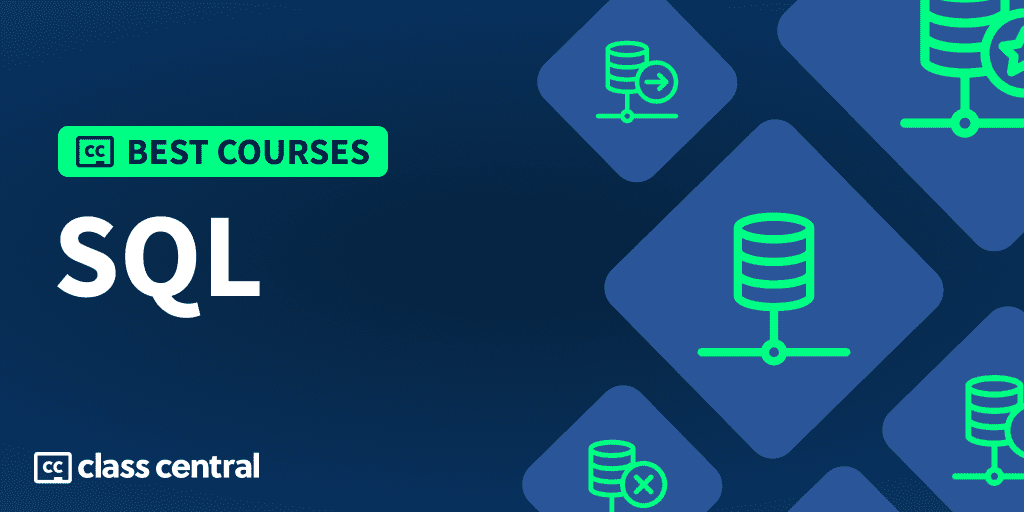
Quick Access:
- For Data Analysts: Udacity, Cloudera
- For Data Scientists: UC, Davis
- Relational Databases: Stanford University
- Intro to SQL: Davidson, Kaggle, SQLBolt, DataCamp, Michigan
Databases are ubiquitous, from websites to banking systems and video games, you name it! SQL will give you the ability to retrieve the valuable data from these databases with ease. If you are looking for the best online SQL course, I’ve created this guide of the 10 best free SQL online courses based on 600+ SQL courses available on Class Central. If you’d like to know how I chose these courses, you can find my methodology below.
But if you’re here for the list, here are my top picks. Click on one to skip to the details:
| Course | Workload | In Brief |
| 1. SQL for Data Analysis (Mode) | 4 weeks long | Best comprehensive course for aspiring data analysts |
| 2. Databases: Relational Databases and SQL (Stanford University) | 16—20 hours | Best course covering both querying and creating databases |
| 3. Introduction to SQL (Davidson College) | 12—20 hours | Best course covering basic and advanced SQL concepts |
| 4. Intro to SQL (Kaggle) | 3 hours | Learn SQL with Google BigQuery using Python and get a free certificate |
| 5. Introduction to SQL (SQLBolt) | 2—3 hours | Short text-based and exercise-based covering both querying and creating databases |
| 6. Foundations for Big Data Analysis with SQL (Cloudera) | 12 hours | Teaches how to analyze big data with SQL |
| 7. Introduction to SQL (DataCamp) | 4 hours | Concise course with free certificate covering querying databases |
| 8. The Structured Query Language (SQL) (University of Colorado Boulder) | 25 hours | Rigorous and lab-based |
| 9. SQL for Data Science (University of California, Davis) | 14 hours | Covers SQL for data scientists |
| 10. Introduction to Structured Query Language (SQL) (University of Michigan) | 16 hours | In-depth course on MySQL |
What is SQL?
SQL is a declarative query language used to retrieve data from relational databases. It is highly-popular across many industries, like data scientists, engineers, digital marketers, and more.
Databases are prevalent everywhere, from websites to banking systems to video games, you name it! High volumes of data produced by billions of users are stored in databases every single day, and in order to retrieve the valuable data from these databases you’ll need to learn SQL.
In fact, databases are so important that most computer science graduates frequently cite their database class as the class that taught them the most valuable skills for their careers and it’s the third most popular programming language among professional developers according to StackOverflow’s 2021 Developer Survey.
Hence, learning SQL will give you the ability to do important data work yourself, making you more appealing to any employer out there.
Quick Note about different SQL dialects
As there are many different flavors of database management systems, there too are many different flavors of SQL, each having their own minor differences. But do not worry! The difference is extremely minor, and all SQL dialects share the same common syntax.
Most of the courses in this ranking focus you on learning the general SQL syntax and concepts, but I’ve also included some courses that are more focused on one specific flavor. Nevertheless, the SQL you’ll learn in those courses will be transferable to all dialects of SQL.
Best Courses Guides Methodology
I built this ranking following the now tried-and-tested methodology used in previous Best Courses Guides (you can find them all here). It involves a three-step process:
- Research: I started by leveraging Class Central’s database with 100K+ online courses and 200K+ reviews. Then, I made a preliminary selection of the 600+ SQL courses by rating, reviews, and bookmarks.
- Evaluate: I read through reviews on Class Central, Reddit, and course providers to understand what other learners thought about each course and combined it with my own experience as a learner.
- Select: Well-made courses were picked if they presented valuable and engaging content and they have to fit in a set of criteria and be ranked accordingly: comprehensive curriculum, release date, ratings and enrollments.
Course Ranking Statistics
Here are some aggregate stats about the ranking:
- The courses combined account for 2M enrollments.
- All of the courses in this course are free or free-to-audit.
- Coursera is the most represented provider in this ranking.
- 9.1K people are following SQL Courses on Class Central.
Without further ado, let’s go through the top picks.
1. SQL for Data Analysis (Mode)
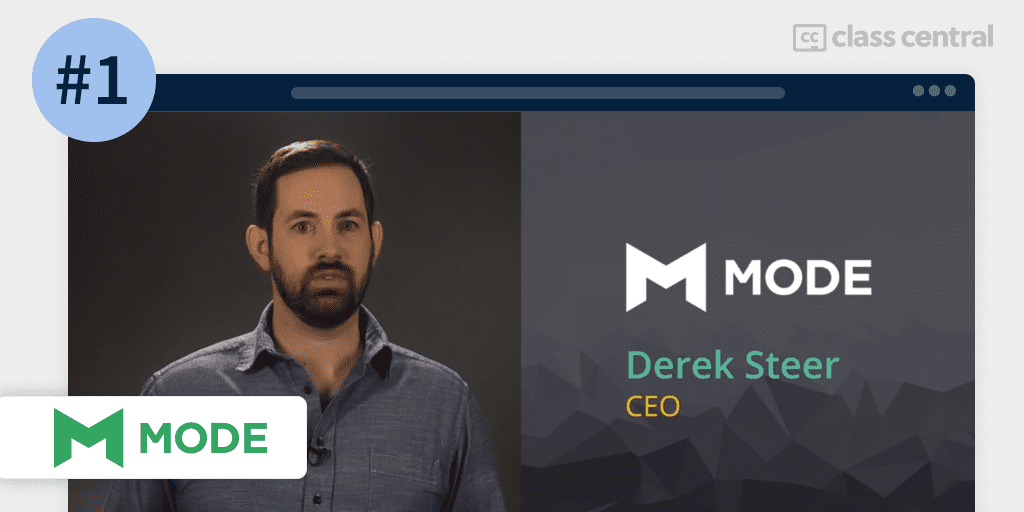
My first pick for the best course to learn SQL is SQL for Data Analysis by Mode, a data science platform that brings together a SQL editor, Python notebook, and R.
The reason why this free course is #1 on this ranking is due to its comprehensiveness, covering many of the important concepts you’ll need to manage and analyze a database, as well as its in-browser SQL coding exercises that will strengthen your practical knowledge.
By the end of this course, you’ll be able to write efficient SQL queries to successfully handle a variety of data analysis tasks.
The only prerequisite for this course is familiarity with working with data in spreadsheets.
What You’ll Learn
The course begins with an introduction to SQL basics for working with a single table. You will learn common SQL commands like SELECT and FROM to get columns from a table, use WHERE to specify a condition that needs to be met, making use of logical operators to combine conditions together.
Then, you’ll learn how to combine data from multiple tables together using JOIN commands, based on mathematical set operators. You’ll learn how to use JOIN, INNER JOIN, LEFT JOIN, and RIGHT JOIN.
One of the reasons why data scientists love SQL is its ability to perform basic statistical operations like SUM, MIN, and MAX. You’ll learn how to use these aggregate functions to bring out insights from the data as well as learn a few other functions like CASE, HAVING, and DATE to furnish your toolkit.
Sometimes one query is too simple or isn’t enough to get the data you need. Luckily, you can write subqueries which are nested querying methods to help you answer complex business questions. You’ll also learn to use temp tables to access a table with more than one query. Additionally, you’ll learn how to clean data in SQL.
The course also includes two advanced SQL topics: one on window functions where you’ll compare one row to another without doing any join, and the other on advanced joins and performance tuning which will be especially helpful for passing interviews.
How You’ll Learn
This course consists of 7 sections and is 4 weeks long. You will learn primarily from watching the lecture videos, reading the course articles provided, and completing the many quizzes that will test your knowledge. An in-built database management system is present in the browser for you to practice writing SQL queries.
| Institution | Mode |
| Provider | Udacity |
| Instructor | Derek Steer |
| Level | Beginner |
| Workload | 4 weeks long |
| Certificate | None |
Fun Facts
- The course has 6.2K bookmarks and 5 reviews on Class Central.
- It is also the #1 SQL course on Class Central’s SQL topic.
If you’re interested in this course, you can find more information about the course and how to enroll here.
2. Databases: Relational Databases and SQL (Stanford University)
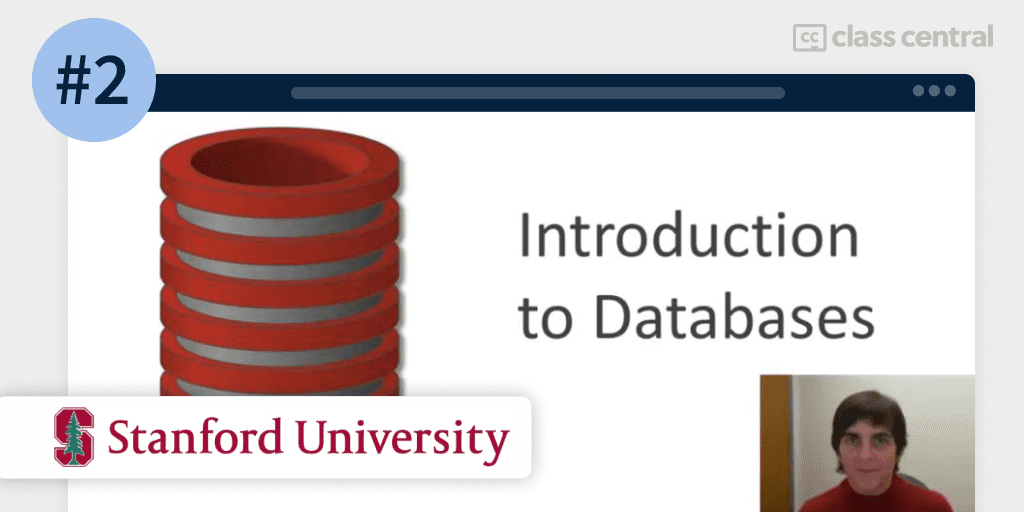
My second pick for the best SQL course is Databases: Relational Databases and SQL by Stanford University.
In this course, you’ll be given an introduction to relational databases, primarily from the viewpoint of the designer, user, and developer of database applications, and comprehensive coverage of SQL, the long-accepted standard query language for relational database systems.
What makes this course special from other edX courses is that all materials are fully free and accessible, although only paying learners will receive a certificate.
Although there are no specific prerequisites for this course, having some knowledge of programming and basic computer science theory will be helpful.
What You’ll Learn
The course begins with an introduction to the relational model and concepts in relational databases. You’ll learn seven reasons why relational databases are so prevalent, and how these reasons manifest themselves in its design and philosophy. You’ll also focus on the database management system and four key concepts: the data model, schema versus data, data definition language (DDL), and data manipulation or query language (DML).
Afterwards, you’ll learn how to query relational databases in general without any focus on a specific language. You’ll learn how DDL is used to design the schema of a database, and how DML is written to query and retrieve data from databases.
Once you have become familiar with the gist behind relational databases, you’ll start learning how to write SQL with the most essential statement: SELECT. Afterwards, you’ll build on your knowledge of SELECT by using statements that modify the results of the query, like adding conditions with WHERE or changing the order results are displayed with ORDER BY.
Next, you’ll learn another important statement of SQL: JOIN. JOIN statements allow you to retrieve data spread out over multiple tables, which most databases consist of. You’ll also learn about aggregation functions like SUM and DISTINCT that describe the nature of data, as well as a few commands that’ll help you modify and make updates to data.
How You’ll Learn
This course is 2 weeks long with each week taking 8—10 hours to complete. You’ll learn primarily by watching lecture videos and completing the 4 SQL exercises that will test your query writing skills.
| Institution | Stanford University |
| Provider | edX |
| Instructor | Jennifer Widom |
| Level | Beginner |
| Workload | 16—20 hours total |
| Enrollments | 58K |
| Certificate | Paid |
Fun Facts
- The course has 695 bookmarks and 2 reviews on Class Central.
- This course is one of five self-paced courses on the topic of Databases, with the follow-up course to this being Databases: Advanced Topics in SQL.
- Jennifer Widom is the Frederick Emmons Terman Dean of the School of Engineering and the Fletcher Jones Professor in Computer Science and Electrical Engineering at Stanford University.
If you’re interested in this course, you can find more information about the course and how to enroll here.
3. Introduction to SQL (Davidson College)

My third pick for the best SQL course is Introduction to SQL from Davidson College.
In this free-to-audit 4 weeks limited-access course, you’ll pick up the skills needed to query and analyze data from complex relational databases through the lens of the Postgres flavor of the SQL language (although most of the syntax you’ll learn are shared among the other SQL flavors).
You’ll learn the history of SQL, before moving on to learning the basics commands that every beginner needs to know. Then, you’ll move further and learn the advanced concepts within SQL.
There are no prerequisites for this course.
What You’ll Learn
The course begins by narrating the history of SQL. You’ll learn what a relational database is, how it relates to SQL, and why SQL is a great tool to learn. You’ll also understand why SQL has so many different flavors.
Then, the course teaches you some basic SQL like how to structure an SQL query, how to select data from a table, how to set filters for your query, how to aggregate data with functions, and a lot more commands that relate to data within a single table.
Next, the course introduces you to the concept of JOINs. You’ll learn when and how to use joins to combine data from multiple tables together, as well as how to inspect and manipulate data within a database. Finally, you’ll end the course by learning about analytic functions and how to pivot a database.
How You’ll Learn
This course is 4 weeks long with each week taking 3—5 hours of study. You’ll learn by watching the lecture videos and reading the course materials.
For paying learners, each week ends with a quiz that will test you on the weekly material. For your final exercise, you’ll be given a database and some questions that you’ll have to answer by analyzing the data, putting your skills into practice.
| Institution | Davidson College |
| Provider | edX |
| Instructor | Pete Benbow |
| Level | Beginner |
| Workload | 12—20 hours total |
| Enrollments | 12K |
| Certificate | Paid |
Fun Facts
- The course has 51 bookmarks on Class Central.
- Pete Benbow has 10 years of experience working with SQL databases, especially on Microsoft SQL Server and Oracle databases, and is also a Microsoft Certified Trainer.
If you’re interested in this course, you can find more information about the course and how to enroll here.
4. Intro to SQL (Kaggle)
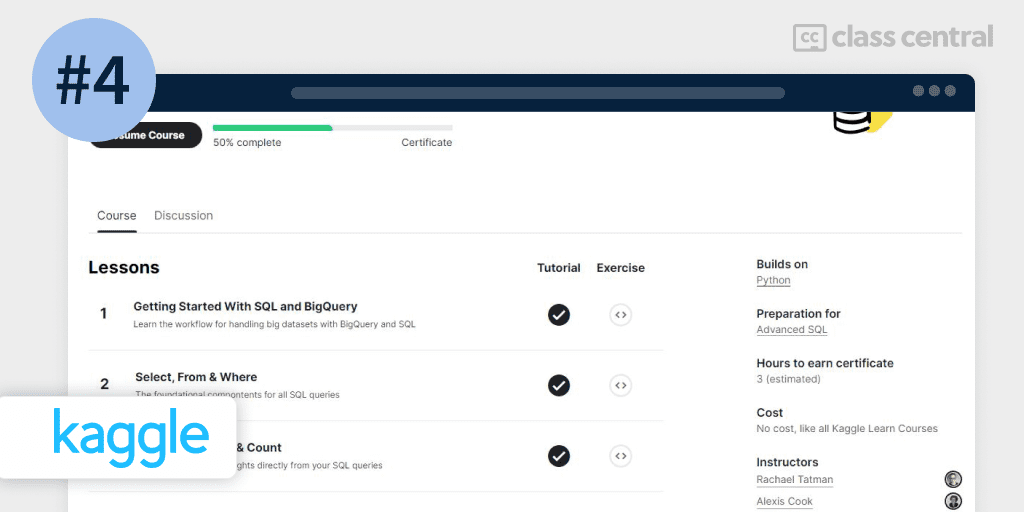
If you know some basic Python and are interested in data science, Intro to SQL is just for you!
In this course with free certification, you’ll learn SQL for working with databases using Google BigQuery. By the end of the course, you’ll know how to gather insights directly from big datasets with SQL queries by ordering, organizing and combining results.
To take this course, you’ll need basic knowledge of Python.
What You’ll Learn
You’ll begin the course with an introduction to SQL and BigQuery. SQL is the database management programming language, while BigQuery is Google’s web service that’ll let you apply SQL to huge data sets. You’ll learn the basics of accessing and examining BigQuery datasets.
Afterwards, you’ll learn the basic anatomy of an SQL query. You’ll start getting data from tables with SELECT and FROM, and then filter the data through conditions with WHERE. You’ll slowly build on your query piece by piece by learning a few additional commands, like GROUP BY to collect columns together and ORDER BY to sort data.
SQL also provides functions that’ll allow you to summarize and get a statistical overview of your data, like COUNT and SUM. You’ll also learn how to conveniently clean up data returned by your query by renaming your returned columns with AS, and writing nested queries with WITH.
The final section of the course discusses how to deal with data that is spread across multiple tables. You’ll learn how to use JOIN to combine data sources together, proving itself useful for many real-world problems.
How You’ll Learn
This course is made up of 6 lessons and is 3 hours long in total. You’ll learn by reading through the provided Jupyter notebooks. After each lesson, you’ll do hands-on coding in an exercise notebook to help strengthen your knowledge of the material. Once you have completed each exercise, you’ll earn your free certificate.
| Institution | Kaggle |
| Instructor | Rachael Tatman and Alexis Cook |
| Level | Beginner |
| Workload | 3 hours total |
| Certificate | Free |
Fun Facts
- Kaggle provides a variety of courses related to data science with free certificates. Check them out if you’re an aspiring data scientist!
- Rachael Tatman is a developer and data science educator who specializes in language technology, while Alexis is an AI educator currently working as a Developer Relations Engineer for Google.
If you’re interested in this course, you can find more information about the course and how to enroll here.
5. Introduction to SQL (SQLBolt)
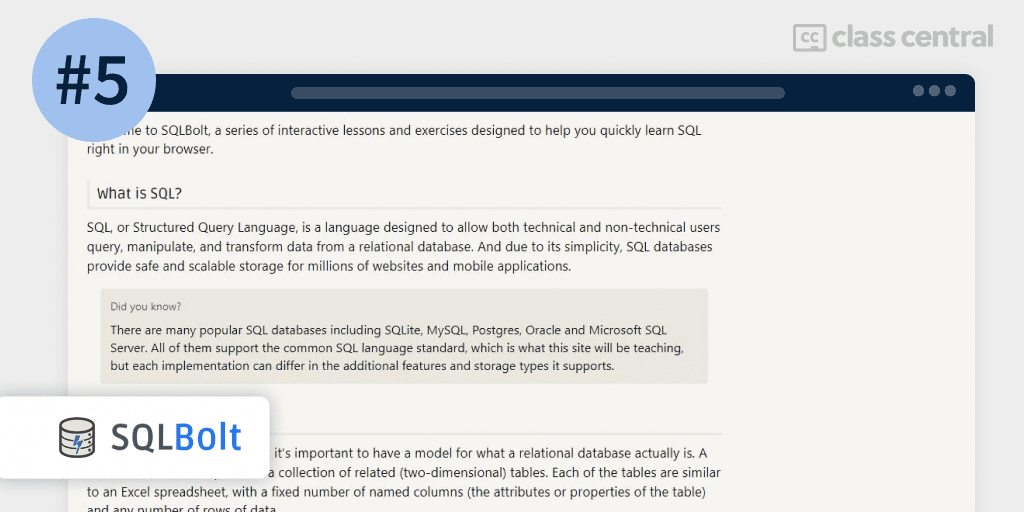
SQLBolt aims to get you started writing SQL as quickly as possible through free interactive browser-based lessons and exercises.
You’ll learn not only how to formulate an SQL query and get the data you need from an existing database, but you’ll also learn how to create new tables from scratch.
There are no prerequisites for this course.
What You’ll Learn
The course starts simple by teaching you how to write an SQL query. You’ll learn basic operations like SELECT and DELETE, and constraining or filtering your queries with conditionals like WHERE. You’ll also learn how to use SQL functions like COUNT() and AVG() to help you understand your data.
Then the course teaches you how to use JOIN, an essential concept needed to truly master the SQL language. JOINs are used to merge results of queries from multiple tables together to produce a single table. You’ll learn about the different kinds of JOINs, like the INNER JOIN and OUTER JOIN.
In the final parts of the course, you’ll learn how to alter the table directly. You’ll learn how to insert, update, and delete rows from a pre-existing table, and also how to create a new table, alter the properties of a pre-existing table, and drop tables to delete them.
How You’ll Learn
This course consists of 18 core lessons and will take around 2 to 3 hours to complete. You’ll learn primarily from reading the articles and completing the embedded browser SQL coding exercises.
| Institution | SQLBolt |
| Level | Beginner |
| Workload | 2—3 hours total |
| Certificate | None |
Fun Facts
- SQLBolt also has lessons on intermediate SQL Topics like subqueries and set operations.
If you’re interested in this course, you can find more information about the course and how to enroll here.
6. Foundations for Big Data Analysis with SQL (Cloudera)
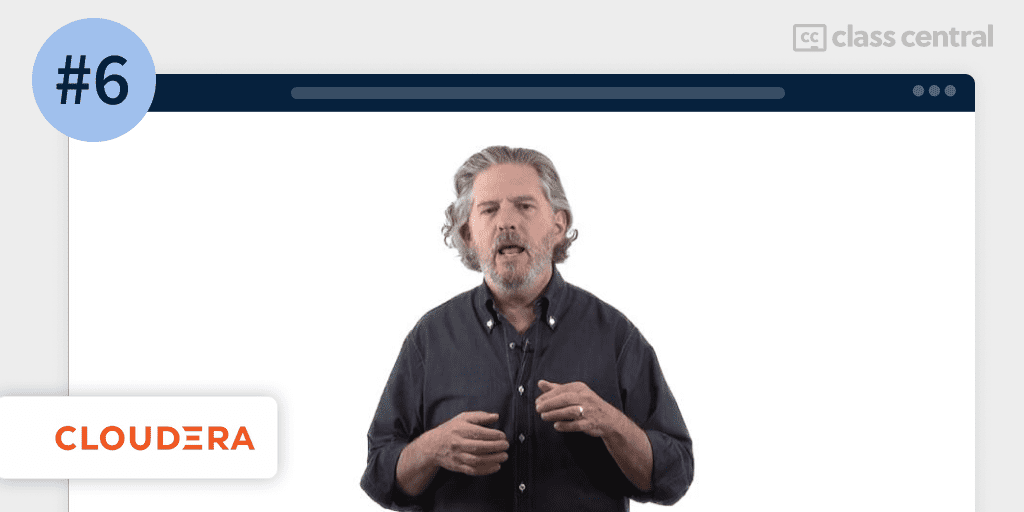
Foundations for Big Data Analysis with SQL by Cloudera will teach you the concepts and vocabulary shared by database practitioners such that you can work confidently with all sorts of databases.
In this free-to-audit course, you’ll learn how to use SQL for interacting with big data. You’ll begin with an overview of data, database systems, and SQL, then learn the characteristics of big data and SQL tools for working on big data platforms, before ending with some hands-on database exploration practice.
No prior knowledge of SQL and big data is required to take this course.
What You’ll Learn
The course begins by answering the question: What is data and what are databases? You’ll discuss the broad uses of database systems and relational databases.
Once you have that covered, you’ll learn the concepts and specialized vocabulary used by all users of SQL and relational databases starting with the fundamentals of database design, like what primary keys, foreign keys, and database triggers are.
The course then covers the main characteristics of big data stores. You’ll learn the “three V’s” of big data: volume, velocity, and variety, and understand the differences between big data and relational databases.
Unfortunately, big data and SQL are not a perfect fit — relational databases don’t just pick up and move over to encompass Big Data. You’ll learn how some technologies adapt SQL to big data, and how these systems handle metadata differently from traditional relational systems. You’ll also consider the options for storing Big Data in your own company data centers or in cloud storage and you’ll see why you might choose one option over the other.
Finally, the course ends by focusing on the two widespread technologies: Apache Hive and Apache Impala. You’ll have hands-on practice with these tools where you’ll interact with data, explore the data, and write a report concerning your investigation.
How You’ll Learn
This course is 5 weeks long, with 12 hours worth of material. You’ll learn primarily from watching the lecture videos, sharing thoughts and ideas in discussion prompts, and going through the course readings.
If you’re paying for certification or specialization, you’ll have access to the weekly quizzes that’ll test your knowledge of the material, as well as a peer review for the final project.
| Institution | Cloudera |
| Provider | Coursera |
| Instructor | Glynn Durham |
| Level | Beginner |
| Workload | 12 hours total |
| Enrollments | 43K |
| Rating | 4.8 / 5.0 (1K) |
| Certificate | Paid |
Fun Facts
- The course has 67 bookmarks on Class Central.
- Glynn Durham is a senior instructor at Cloudera, with previous experience working for Oracle, Forté Software, MySQL, spending five or more years at each.
If you’re interested in this course, you can find more information about the course and how to enroll here.
7. Introduction to SQL (DataCamp)
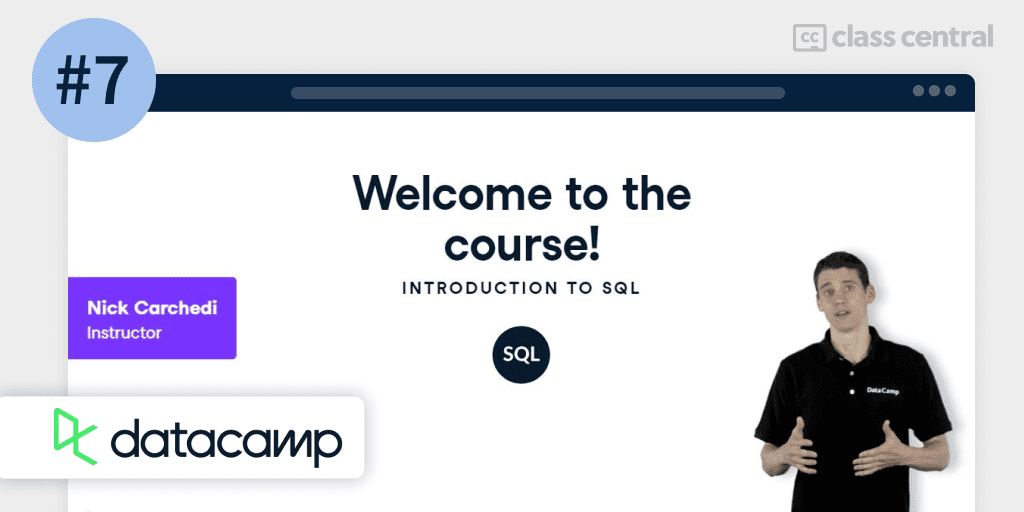
DataCamp’s Introduction to SQL teaches you the general SQL syntax shared by many types of databases like PostgreSQL, MySQL, SQL Server, and Oracle.
By the end of this course with a free certificate, you’ll be able to select specific columns, filter rows satisfying a condition, use aggregate functions to summarize data, and sort and group your results.
What You’ll Learn
The course begins with a brief introduction to relational databases. First, you’ll learn about the structure and anatomy of a database. Then, you’ll learn how to select one or more columns with the SELECT statement and get to know a few functions.
Afterwards, you’ll study how to filter through rows using basic comparison operators like AND, OR, and BETWEEN. You’ll also learn how to filter for text and words using the WHERE statement, helping you dig up chunks of valuable information.
In the third section, the course discusses aggregate functions that help summarize data into a simple statistic. You’ll use aliases to help name your query results and make it much more readable.
In the final section, the course teaches how to sort with ORDER BY and group results with GROUP BY. Although GROUP BY is tricky to learn at first, you’ll realize how useful it is when you’re filtering through two combined conditions at the same time. You’ll end the course with a final exercise where you’ll put everything you’ve learned together.
How You’ll Learn
This course consists of 4 sections and is 4 hours long in total. You’ll learn through a combination of reading articles, interactive coding exercises, and multiple choice quizzes.
| Institution | DataCamp |
| Instructor | Nick Carchedi |
| Level | Beginner |
| Workload | 4 hours total |
| Enrollments | 1.4M |
| Certificate | Free |
Fun Facts
- DataCamp offers many data science and business courses, but only six of them are completely free, this being one of them.
- Nick is a Product Manager at DataCamp. His passion for teaching data science began in graduate school, where he was heavily involved in tutoring fellow students, developing the Johns Hopkins Data Science Specialization, and building the swirl R package.
If you’re interested in this course, you can find more information about the course and how to enroll here.
8. The Structured Query Language (SQL) (University of Colorado Boulder)
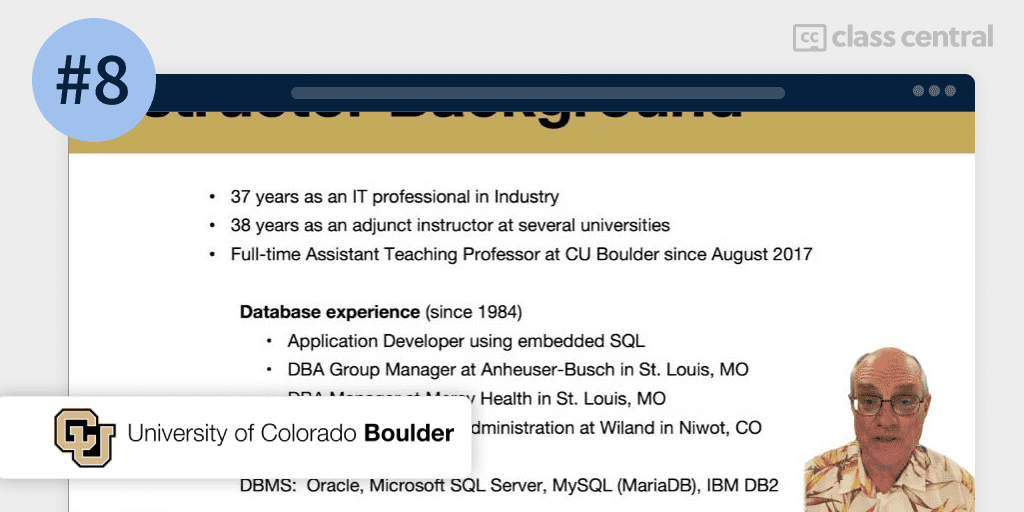
The University of Colorado Boulder’s course called The Structured Query Language (SQL) teaches you all there is to know about SQL.
In this comprehensive course, you’ll focus on mastering the standard SQL commands and syntax such that you are able to analyze data within a huge relational database. You will not only cover the SELECT statement for retrieving data and creating analytical reports, but also the DDL (“Data Definition Language”) and DML (“Data Manipulation Language”) commands necessary to create and maintain database objects.
There are no prerequisites for this course.
What You’ll Learn
The course begins with a discussion on where SQL came from, its history and its origins, before settling on the most used SQL statement — SELECT. When you’re programming in SQL, a lot of what you do is going to be SELECT statements. Hence, you’ll spend quite a bit of time in this course learning about the SELECT statement and all the different things you can do with the SELECT statement.
You’ll take a look at group functions and how you can use group functions to do SubTotals. Then, you’ll learn about subqueries, which can embed one query inside of another query. When the embedded query runs it returns results that are used by the outer query. You’ll also investigate how to get data from multiple database tables using the SQL Join, which are based on mathematical set operations and are really powerful for pulling data from many tables.
Afterwards, you’ll learn about DDL and DML, Data Definition Language and Data Manipulation Language. Essentially, these are creating, updating, modifying, and deleting tables and their records. You’ll be given a few advanced SQL concepts like VIEW, CASE and UNION to practice with.
How You’ll Learn
This course is 6 weeks long with 25 hours worth of material. You’ll learn primarily from watching the lecture videos and reading the assigned course materials.
Learners will have access to a total of 13 labs, where you’ll practice querying SQL commands from a database. Only paying learners however will be graded and see the solutions. In addition, paying learners will also have quizzes that’ll test their understanding.
| Institution | University of Colorado Boulder |
| Provider | Coursera |
| Instructor | Alan Paradise |
| Level | Beginner |
| Workload | 25 hours total |
| Enrollments | 8K |
| Rating | 4.8 / 5.0 (72) |
| Certificate | Paid |
Fun Facts
- The course has 166 bookmarks on Class Central.
- This course is a part of the Databases for Data Scientists Specialization, with the next course in line being Advanced Topics and Future Trends in Database Technologies.
If you’re interested in this course, you can find more information about the course and how to enroll here.
9. SQL for Data Science (University of California, Davis)
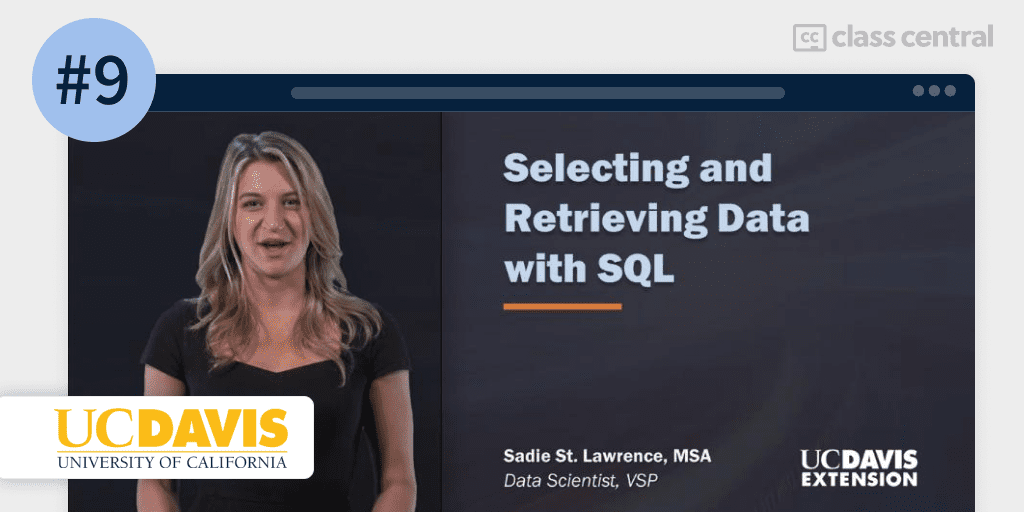
SQL for Data Science by the University of California, Davis is designed to give you a primer in the fundamentals of SQL and working with data from the perspective of a data scientist.
By the end of this free-to-audit course, you’ll be able to ask the right questions to deliver valuable insights for your organization, write complex queries to help you select and filter data from tables, create new tables and move data into them, and use SQL as a professional to shape your data for targeted analysis purposes.
No prior experience with SQL is required to take this course.
What You’ll Learn
The course begins with an explanation of what SQL is and how it differs from other computer languages (Hint: it is declarative instead of procedural!). After learning about the different relationships databases can have between one another, you’ll learn how to write a SELECT statement to grab data you need from a database.
Then, you’ll learn a few more basic SQL clauses and operators to really supercharge your SQL abilities. You’ll know how to aggregate data, filter them, sort them, and group them all within one query.
Subqueries and joins are another powerful tool to have in your skillset. You’ll know when to use subqueries to further refine your select statements, and use joins to combine and select data from two or more tables. Lastly, you’ll understand the importance of using aliases, pre-qualifiers, and comments to make your SQL code cleaner.
The last section of the course concerns modifying and analyzing data with SQL. You’ll study how to modify strings by concatenating, trimming, changing the case, and using the substring function especially when it comes to date and time strings, as well as understanding case statements and data governance and profiling. Finally, you’ll learn several fundamental principles when using SQL for data science.
How You’ll Learn
This course is 4 weeks long with 14 hours worth of material. You’ll learn by watching the lecture videos, reading the course materials, and test your knowledge through practice quizzes.
For those paying for the certification, you’ll have access to two types of graded weekly quizzes: a theoretical quiz and a coding quiz. You’ll end the course with a graded peer review.
| Institution | University of California, Davis |
| Provider | Coursera |
| Instructor | Sadie St. Lawrence |
| Level | Beginner |
| Workload | 14 hours total |
| Enrollments | 413K |
| Rating | 4.6 / 5.0 (13K) |
| Certificate | Paid |
Fun Facts
- The course has 576 bookmarks on Class Central.
- Sadie St. Lawrence is the Founder and CEO of Women in Data, the #1 Community for Women in AI and Tech.
If you’re interested in this course, you can find more information about the course and how to enroll here.
10. Introduction to Structured Query Language (SQL) (University of Michigan)
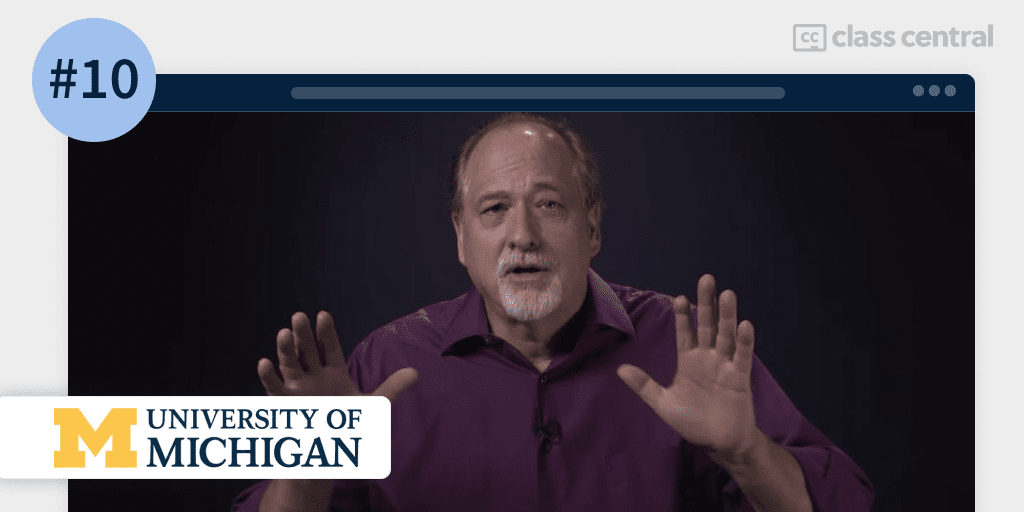
Introduction to Structured Query Language (SQL) by the University of Michigan will start you off learning SQL through the MySQL flavor. You’ll learn how to create and design databases with MAMP or XAMPP, and learn the basic syntax of the MySQL language.
Although there are no prerequisites for this free-to-audit course, having knowledge of PHP programming would be helpful.
What You’ll Learn
The course begins with instructions on how to install a text editor and a PHP development environment, either MAMP or XAMPP.
Once you have gotten the technical part set up, the course gives an overview of databases and how they are miles better than the regular old Excel or csv files when it comes to reducing data redundancy. You’ll then learn the basic syntax of the SQL language like its common operations (SELECT, INSERT, DELETE, UPDATE) and data types.
Designing a database is hard work. Sometimes, a database can get really complex with tens of tables interlinking between one another. You’ll learn about database normalization, important principles that’ll guide your design, and mapping out your database with a data schema.
A table may have a Many-To-Many relationship. For example, a student may have many classes, and a class may have many students. You’ll learn how to model such relationships in the final part of the course to ensure that your database is as storage and time efficient as possible.
How You’ll Learn
This course is 4 weeks long with 16 hours worth of material. You’ll learn primarily from watching the video lectures and reading the provided course articles. Additionally, you’ll have access to the practice quizzes to test your knowledge.
If you’re paying for the certificate, you’ll complete two graded projects: creating a single-table SQL database and a many-to-many database.
| Institution | University of Michigan |
| Provider | Coursera |
| Instructor | Charles Severance |
| Level | Intermediate |
| Workload | 16 hours total |
| Enrollments | 144K |
| Rating | 4.8 / 5.0 (4.5K) |
| Certificate | Paid |
Fun Facts
- The course has 1.6K bookmarks on Class Central.
- This course is the second course of four of the Web Applications for Everybody Specialization. The course before this is Building Web Applications in PHP.
- Charles Severance (a.k.a. Dr. Chuck) is a Clinical Professor at the University of Michigan School of Information. He has taught many other computer science courses, his most famous course being Programming for Everybody (Getting Started with Python).
If you’re interested in this course, you can find more information about the course and how to enroll here.







